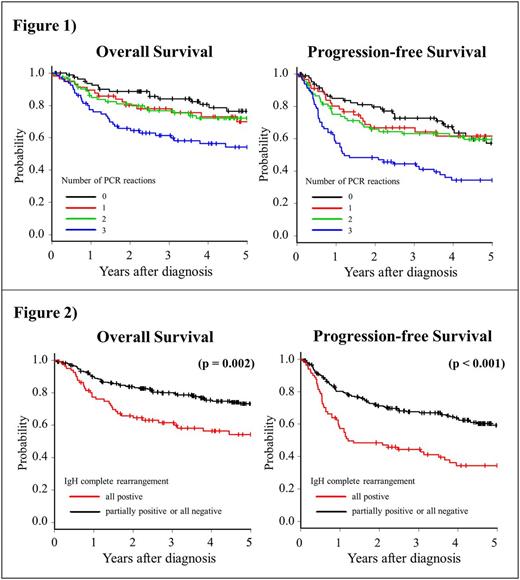Abstract

Introduction: In several B-cell malignancies, such as chronic lymphocytic leukemia and mantle cell lymphoma, the somatic hypermutation (SHM) status of immunoglobulin heavy chain (IgH) variable region (VH) significantly correlates with clinical outcome. Diffuse large B-cell lymphoma (DLBCL) usually contains a number of VH SHMs, with considerably variable frequency. However, there have been few reports about the association between VHSHM frequency and clinical outcome in DLBCL.
The BIOMED-2 multiplex PCR protocol is one of the standardized methods for detecting IgH gene rearrangements, and has been used to prove clonality in B-cell lymphomas. VH SHMs in the germinal center prevent proper annealing of the applied PCR primers, rendering clonal VH rearrangements undetectable by this protocol. Thus, the complete IgH rearrangement pattern produced by the BIOMED-2 protocol is expected to reflect the frequency of VH SHMs. In this study, we investigated the prognostic impact of complete IgH rearrangement pattern on patients with DLBCL, and analyzed the correlation between complete IgH rearrangement pattern and VH SHM frequency by Sanger sequencing.
Materials and Methods: We retrospectively identified 386 patients diagnosed with de novo DLBCL that received anthracycline-based immunochemotherapy at Kobe City Medical Center General Hospital from January 2005 to June 2015. We excluded 83 patients because fresh samples were not available for PCR analysis, and a total of 303 patients were enrolled. Based on the BIOMED-2 protocol, complete IgH rearrangement was detected by three PCR reactions using three VH forward primer sets: framework region (FR) 1, FR2, and FR3. The primary endpoint was 5-year overall survival (5-yr OS). The secondary endpoint was 5-year progression-free survival (5-yr PFS). OS and PFS were estimated using the log-rank test. Multivariate analysis using the Cox proportional hazard ratio was performed for 5-yr OS. For VH sequencing analysis, the cryopreserved PCR products of 42 available samples were sequenced directly using both forward and reverse primers, and for each sequenced sample, the percentage of VH identity to the closest germline gene was calculated, using the immunoglobulin gene database (IMGT/V-QUEST).
Results: Of the 303 patients enrolled (median age: 69 years old), 183 patients (60.3%) had advanced stage disease and 148 (48.8%) had a high-intermediate or high International Prognostic Index (IPI) score. The median follow-up was 60.6 months (2.0-133.8 months). Complete IgH rearrangement was detected in 176 (58.1%), 172 (56.8%), and 113 (37.2%) of patients using the FR1, FR2, and FR3 primer sets, respectively. In total, 80 patients (26.4%) were positive for all three PCR reactions, 82 (27.1%) for two, 57 (18.8%) for one, and 84 (27.7%) had completely negative results. We compared the 5-yr OS and PFS among these subgroups (Figure 1), and observed that the probability of survival decreased with accumulation of positive PCR results. As shown in Figure 2, both the 5-yr OS and PFS were significantly worse for patients with all three reactions positive for complete IgH rearrangement (OS: 54.2% vs 73.2% p=0.002; PFS: 34.4% vs. 59.3%, p<0.001). In multivariate analysis adjusted by IPI score, complete IgH rearrangement detected by all three PCR reactions was significantly correlated with poor prognosis (hazard ratio: 2.13; 95% CI: 1.38-3.26; p<0.001).This classification also allowed subgroups with unfavorable prognosis to be identified, even among patients with a high-intermediate or high IPI score (5-yr OS: 28.0% vs. 62.9%, p<0.001). Moreover, VH sequencing analysis of 42 available samples confirmed that patients with complete IgH rearrangement in all three PCR reactions had significantly lower VH gene SHMs than other groups (median value of VH identity; 91.9% vs 84.0%, p<0.001).
Conclusion: Complete IgH rearrangement detected by all three primer sets in the BIOMED-2 PCR protocol was associated with poor prognosis in patients with DLBCL. Combined with the additional sequencing analysis, this suggests that the lower levels of VH SHMs may be associated with unfavorable prognosis in DLBCL.
No relevant conflicts of interest to declare.
Author notes
Asterisk with author names denotes non-ASH members.

This icon denotes a clinically relevant abstract


This feature is available to Subscribers Only
Sign In or Create an Account Close Modal